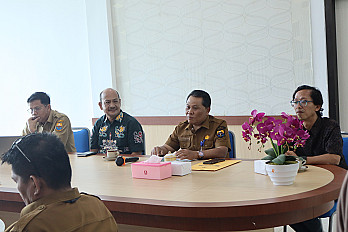
-
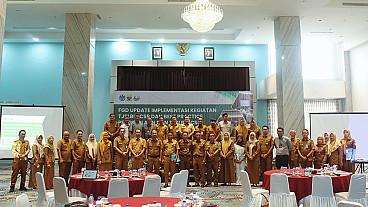
Jambi, 13 October 2025 – The Jambi Provincial Government reaffirmed its commitment to strengthening the role of Corporate Social and Environmental Responsibility (CSR) as a crucial instrument for sustainable development and emissions reduction. Through activities facilitated by the Jambi Provincial Development Planning Agency (Bappeda), various stakeholders from the central, provincial, district/city, and private sectors gathered to align CSR program direction with regional development priorities.
In his remarks, the Secretary of the Jambi Provincial Development Planning Agency (Bappeda) highlighted the importance of increasing private sector participation in generating Emission Reduction (ER) within the BioCF ISFL program framework for 2025. Since entering the Pre-Investment phase in 2022, Jambi Province has allocated a budget of IDR 82.38 billion, with support from five key regional agencies: Bappeda, the TPHP Office, the Plantation Office, the Environmental Office, and the Forestry Office.
This meeting specifically discussed the implementation of the Community Service (TJSLBU)/CSR program that supports emission reduction and showcased best practices in CSR fund management in various regions. The main objective was to build synergy and synchronization between the government and businesses so that CSR becomes an integral part of regional development.
The Strategic Role of the Social Service and the Community Service Forum
The Head of the Jambi Province Social Service and Civil Registration Agency (Dukcapil), represented by the Head of the Social Empowerment Division, emphasized the Social Service's role in providing guidance, supervision, and capacity development for businesses in implementing Community Service (TJSLBU). Based on Ministerial Regulation Number 9 of 2020, every business entity is required to periodically report CSR activities to the government, with reports containing program information, budgets, and activity documentation.
In 2024, various initiatives implemented with CSR funding, such as road infrastructure improvements and the procurement of transportation for official operations, demonstrated the business sector's tangible contribution to regional development. The Jambi Province Community Service Forum is also developing a web-based system to strengthen its database and enhance the professionalism of its administrators until 2027.
Active Regency/City Involvement
A presentation from the Tanjung Jabung Barat Regency Development Planning Agency (Bappeda) revealed that the implementation of Corporate Social and Environmental Responsibility (TJSLP) has become part of the regional development strategy. Although not yet optimally coordinated, the local government has made various efforts to ensure more active and targeted corporate involvement. From the village development planning meeting (Musrenbangdes) to the proposal of priority programs, companies are directed to fund activities that cannot be covered by the regional budget (APBD).
The Tanjung Jabung Timur Regional Development Planning Agency (Bappeda) also emphasized the importance of synergy between CSR and regional programs. Their CSR policy, stipulated in Regional Regulation No. 13 of 2013, is geared toward addressing the real needs of the community, with a focus on strengthening the economy, socio-cultural environment, and developing village infrastructure.
Discussion: Challenges and Recommendations
The discussion forum revealed common challenges across various regencies/cities, particularly in reporting and coordination with companies. Several regions, such as Sarolangun and Batanghari, complained about a lack of reporting from business entities and low private sector awareness in supporting government programs.
In response, several strategies from other regions were outlined. Tanjung Jabung Barat Regency, for example, encourages intensive communication and provides annual awards to active companies as a token of appreciation. Meanwhile, in Tanjung Jabung Timur, direct communication between the regional head and company leaders is considered effective in increasing participation.
The Way Forward: Regulations and Standardization
As a follow-up, the Jambi Provincial Development Planning Agency (Bappeda) plans to draft a Governor's Regulation (Pergub) as a derivative of the Provincial CSR Regulation. This Regulation will regulate coordination mechanisms, the role of the facilitation team, and an integrated reporting system. Furthermore, the management of the Jambi Provincial CSR Forum will be overhauled to improve coordination effectiveness.
The Jambi Provincial Social Services Agency is also mandated to strengthen monitoring and evaluation of CSR implementation at the district/city level. Regional governments are also asked to adjust their regulations to align with national regulations, particularly Social Affairs Ministerial Regulation No. 9 of 2020.
2025 Focus: Social and Environmental Improvement
Jambi Province is committed to directing CSR funds to two main targets: reducing carbon emissions and improving social welfare. Twelve categories of community groups are prioritized as beneficiaries, ranging from vulnerable children, neglected elderly, people with disabilities, disaster victims, to the poor and remote indigenous communities.
CSR is no longer merely a corporate formality; it has become a strategic part of sustainable development. Through synergy between the government and businesses, Jambi Province hopes to realize inclusive, green, and sustainable development that favors the community and the environment.
Conclusion
This meeting serves as the initial step to unify perceptions and take concrete steps to integrate CSR into the regional development agenda. Cross-sectoral synergy and strong regulations are expected to make Jambi a model for successful and sustainable CSR implementation in Indonesia.
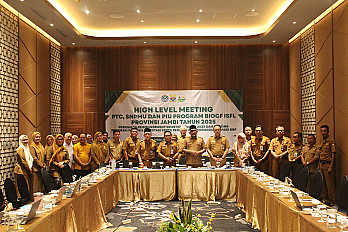
Jambi, October 2025 — The Jambi Provincial Government, through the Regional Development Planning Agency (Bappeda), together with various Regional Apparatus Organizations (OPDs) and supporting institutions, continues to accelerate the implementation of the BioCarbon Fund Initiative for Sustainable Forest Landscapes (BioCF-ISFL) program, which will reach a critical stage in 2025 and 2026. In a cross-sector coordination meeting involving various technical agencies and partners, the Head of the Jambi Provincial Bappeda, Ir. Agus Sunaryo, M.Si., emphasized the need for accelerated and synchronized steps between OPDs. "The 2025 implementation projection only runs until October. Several activities have not yet been implemented because they are still awaiting changes to the Regional Budget (APBD)," he said. He added that for 2026, implementation will only last until May, with the reimbursement process already underway in June. Furthermore, there is a significant discrepancy in the budget ceiling. The RKA document lists only IDR 4 billion, while coordination with the Ministry of Environment and Forestry and the World Bank indicates a potential ceiling of up to IDR 6 billion. "This requires follow-up in the form of a LEMTARA agreement and performance allocation," Agus emphasized.
Input from Technical OPDs: Field Challenges
A representative from the Environmental Agency (DLH), Adi, reported that monitoring and evaluation (monev) activities for safeguards presented a particular challenge. "Many activities were conducted in the field, while the use of budgets for vehicle rentals was a finding during the audit," he said. Furthermore, the DLH is also responsible for implementing customary territory recognition and public consultations involving various stakeholders. From the Forestry Agency's perspective, budget efficiency issues have led to shifts in official travel. Forest Management Units (KPH) also voiced concerns. "KPHs are afraid that once the program is underway, they won't be able to reimburse," said the agency representative. The Plantation Agency noted that the projected 2025 budget is approximately IDR 985 million, allocated for five priority activities. While the figure is not large, clarity and timeliness of implementation remain key concerns.
Regulatory Barriers and Administrative Solutions
According to Agus Sunardi of the Regional Revenue and Finance Management Agency (BPKPD), political dynamics at the Budget Agency (Banggar) level are one of the main obstacles. Nevertheless, he is optimistic that the APBD can be finalized on September 24, with ratification scheduled for September 26. "After ratification, the documents will be sent to the Ministry of Home Affairs three days later. We estimate that the revised budget can be executed between October 27-31," Agus explained. He also emphasized that the reimbursement process has a one-month deadline and that the verification process is expected to be completed by December. Regarding the issue of official vehicle use, the BPKPD reminded that based on the latest presidential regulation, only regional heads and heads of agencies are permitted to use rented vehicles for official activities. To avoid audit findings, efficient operational vehicle management among regional government agencies (OPDs) is recommended. Regarding the budget increase from IDR 4 billion to IDR 6 billion, Agus stated that the additional IDR 2 billion can be immediately distributed to technical SKPDs. "We will also strive to ensure that the DLH's findings are categorized as administrative findings, not serious violations," he added.
Recommendations and Strategic Steps
The coordination meeting also produced several important recommendations:
- The program application process from villages must go through the stages of allocation, activity proposal, verification, and approval by the province and the ministry.
- Criteria for Non-Governmental Organizations (NGOs) include domicile in the region, a minimum of 7 years of organizational age, and a minimum of 5 years of experience in the relevant field.
- The Provincial BSM Team has been formed and is currently updating the training module.
- SOPs related to benefits identification, risk mitigation, and LEMTARA selection have been developed.
- A draft Gubernatorial Regulation has been prepared and is being finalized.
- The technical team is also developing implementation guidelines (juklak) and technical guidelines (juknis).
- Validation of NGOs and universities is carried out to ensure credibility and avoid conflicts of interest.
- The preparation of the BSP documents, SOPs, operational guidelines, and technical guidelines needs to be expedited so they are ready before funds are transferred or the Emission Reduction Payment Agreement (ERPA) is signed.
- Recognition of customary territories through a Regent's Decree is a priority so that indigenous peoples' demands can be legally accommodated.
- Adjustment of official travel schedules between the central and regional governments needs to be considered for greater effectiveness and efficiency.
Given the various technical, administrative, and political challenges faced, cross-sector collaboration and accelerated decision-making are key to the successful implementation of the BioCF-ISFL program in Jambi Province. Commitment from all parties to aligning policies, budgets, and field implementation is essential to achieve maximum results in 2025 and 2026.
-thumb.jpg )
Jambi, September 3–4, 2025 — The Jambi Provincial Government, through the Regional Development Planning Agency (Bappeda), held a Coordination Meeting for the Preparation of the Phase I Emission Reduction Monitoring Report (ERMR) for the Jambi Emission Reduction Program (ERP) for the 2020–2022 period. This event served as a crucial opportunity to ensure Jambi Province's readiness to move towards results-based payments (RBP) through a collaborative mechanism with the World Bank.
Opening and Strategic Direction
The meeting was opened by Ir. H. Sepdinal, ME, representing the Head of Bappeda. In his remarks, he emphasized that the preparation of the ERMR is a strategic step in efforts to reduce greenhouse gas emissions in Jambi. The Phase I ERMR includes seven chapters and five appendices prepared by the MAR team with cross-sectoral contributions, including safeguards, monitoring and evaluation (M&E), the Benefit Sharing Mechanism (BSM), and other aspects.
BIOCF Program Progress and Pre-Investment
As of mid-2025, the BioCarbon Fund (BIOCF) program remains in the pre-investment phase, focusing on strengthening institutions and policies. Negotiations on the Emission Reduction Payment Agreement (ERPA) with the World Bank have been delayed due to updates to the environmental, social, and benefit sharing plan (BSP) documents. Despite this, budget realization has reached 77.2%, despite various operational challenges in the field.
Emissions Data Compilation and Consistency
During the discussion of the ERMR document, meeting participants highlighted the importance of data consistency with national sources such as SignSmart and IPSDH. Activity data, particularly from the agriculture and livestock sectors, is expected to be completed by 2024. The technical team emphasized that all land cover change data will be presented in Excel matrix format to facilitate the verification process and avoid data discrepancies.
Benefit Sharing Plan (BSP): Fairness for All Parties
The BSP preparation is now in the finalization stage. The benefit-sharing plan includes 57% based on performance, 1–1.5% for voluntary palm oil companies, and 5% for small-scale social forestry (PS) groups. The discussion also highlighted the determination of the intermediary institution (Lemtara) for benefit distribution, with three options: a local selection team under the Governor, a central agency, or the BPDLH.
The main challenges lie in the completeness of beneficiary data and field validation. To prevent overlap, the BSP recommends using a single safeguard document, which has been approved since 2022.
Safeguards and Integration of Supporting Documents
The Jambi emission reduction program implements two safeguard systems: the OPBP for free investment and the ISS for result-based payment. It was agreed that there was no need to create new documents, but rather to adapt existing guidelines. Synchronization between the BSP and safeguards is a priority to avoid implementation conflicts.
Carbon Trading and National Registration
The discussion also covered the carbon registration process in the National Registration System (SRN) and its integration with the World Bank's Carbon Asset Tracking System (CATS). All entities, including indigenous communities and NGOs like Warsi, are required to register with the SRN and obtain central government approval. The discussion highlighted the importance of regional regulatory readiness for an effective carbon trading mechanism.
Implementation and Coordination Challenges
Several challenges remain, ranging from limited microdata on carbon asset groups, changes in spatial planning policies, to cross-sectoral synchronization. The Jambi Provincial Government is committed to strengthening coordination and accelerating ERPA negotiations to support the sustainability of results-based payments.
Day Two: Deeper Understanding of Reversal Buffers, Safeguards, and Non-Carbon Benefits
Managing Reversal and Buffer Risks
The discussion on Thursday, September 4, 2025, focused on buffer mechanisms and reversal risks, referring to the 2023 SFL Buffer Requirement. Fifteen percent of total emission reductions will be allocated as a buffer account to anticipate the risk of emission reversals due to fires, floods, land tenure conflicts, or renewed deforestation.
Chapter 6 of the ERMR includes a risk assessment, buffer tool, and a narrative linking Annex 1 safeguards and non-carbon benefits (NCBs). Baseline data, actual emissions, and major events such as El Niño, peat fires, or permit conflicts are the main components of the report.
Safeguard Implementation and ESDD
In this session, Mr. Deddy presented the Environmental and Social Due Diligence (ESDD) assessment, which assesses the program's compliance with World Bank safeguard standards for the 2022–2024 period. The ESDD analysis covers environmental risks, working conditions, biodiversity conservation, and indigenous community involvement.
The Head of Safeguards, Linda, added that monitoring is conducted twice a year and will focus more on peatland management to prevent fires and emissions. Meanwhile, Sahru from the safeguards team reported that the ESDD document has been revised and is ready to be submitted to the World Bank.
Technical Discussion and Follow-up
Meeting participants provided various input, including the importance of assessing the impact of production forest utilization permits under 5 hectares, potential conflicts with national strategic projects, and the need to monitor forest rehabilitation and conservation activities.
It was also agreed upon the importance of regular cross-sectoral meetings to expedite the resolution of technical issues and coordination with central ministries.
Data Monitoring and Supporting Technology
The Monitoring and Evaluation (Monev) Team explained the development of an OCM (Online Collaboration Management) portal for real-time data collection by all sectors and beneficiaries. The use of drones by Forest Management Units (KPH) was also proposed to improve the accuracy of rehabilitation area monitoring. All data will be stored for a minimum of seven years, as stipulated in the cooperation agreement with the World Bank.
Social Forestry and Oil Palm Management
The meeting also discussed the incentive mechanism for oil palm owners under the social forestry scheme. KPHs were urged to conduct strict guidance to prevent land use violations after the PS Decree is issued.
The issue of "jangka benah" (long-term improvement) in oil palm plantations received special attention because it requires realistic and equitable solutions on the ground.
Non-Carbon Benefits: More Than Just Emissions
In addition to emission reductions, Jambi also emphasizes non-carbon benefits (NCBs) such as improved local livelihoods, transparent forest governance, and biodiversity conservation. Supporting data for NCBs will be collected by the Monitoring and Evaluation (M&E) team, supported by spatial imagery and field reports to ensure the accuracy of achievement claims.
Closing: Strengthening the Foundation for Results-Based Payments
The two-day coordination meeting resulted in several important agreements, ranging from data consistency to synchronization of ERMR, BSP, and safeguard documents. With cross-sector synergy and support from all stakeholders, Jambi Province affirms its commitment to becoming a model for implementing results-based emission reduction programs in Indonesia.
The agreed-upon steps are expected to form a strong foundation for the sustainability of the BIOCF program and accelerate the achievement of low-carbon development targets in Tanah Sepucuk Jambi Sembilan Lurah.
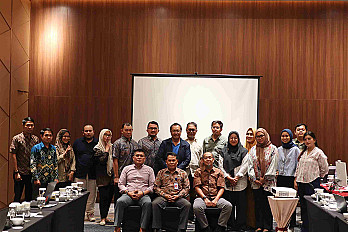
Jambi, September 1–2, 2025 — The IGRK MPV Directorate, together with the Monitoring, Assessment, and Reporting (MAR) Division of the BioCF-ISFL Jambi Province, held a two-day coordination meeting to discuss activity progress, system improvements, and capacity building to support the full implementation of the BioCF-ISFL Program in Jambi Province.
The meeting was attended by various stakeholders, including representatives from local governments, technical institutions, academics, and development partners. The meeting was divided into several sessions with topics including updates on IGRK & MAR progress, land cover map development, SOP revisions, the deforestation early detection system, and optimization of the BioCF ISFL Jambi information portal.
Strengthening the MAR System in the REDD+ Scheme
In the opening session, Agustina Kristin Handayani, S.T., presented the progress of IGRK & MAR activities under the BioCF-ISFL Program framework. She emphasized that MAR plays a crucial role in ensuring the accuracy of emissions data, monitoring interventions, and reporting on REDD+-based emission reduction achievements.
This program focuses on calculating emissions, strengthening the MRV (Measurement, Reporting, and Verification) system, and increasing transparency and accountability at the regional level. The steps leading to full implementation of the MAR system include preparation, trials, evaluation, and full implementation across all BioCF ISFL Jambi intervention areas.
"The progress of MAR implementation has proceeded according to plan, but acceleration is needed in terms of institutional strengthening and cross-agency data integration," she said. Support from both central and regional institutions is key to the successful implementation of the MAR system, which is planned to be implemented in stages until 2026.
Improving Land Cover Map Accuracy
Next, Tantri Janiatri, S.Hut., presented the progress of the documentation to improve the accuracy of the Jambi Province land cover map. The activity was carried out through three Quality Control (QC) stages in Bogor and Jambi between April and June 2025.
The validation process, which involved observing up to 100% of samples, successfully improved the accuracy of land cover data, reaching a consistency level of 99% in 2022. "This data is now suitable as a basis for low-emission development planning in Jambi," said Tantri.
The resulting documentation will serve as an important reference for the implementation of the BioCF ISFL and REDD+ programs. The next stage will involve the development of a more systematic documentation book with the support of the MAR and IPSDH teams.
MAR SOP Revision and Synchronization
In the next session, Dr. Asnelly Ridha Daulay, M.Nat.Res., Ecs., emphasized the need to revise and update the MAR Standard Operating Procedure (SOP). The revision aligns the carbon stock measurement method with the NFI version 2 developed by IPSDH.
He also emphasized the importance of documenting SOP implementation as evidence of field implementation and legalizing the document through a Regional Secretary's Decree to ensure formal validity for all relevant Regional Apparatus Organizations (OPDs).
Furthermore, the reporting frequency for monitoring activities, such as fire and deforestation observations, was agreed to be at least monthly, with daily hotspot monitoring during the dry season.
Timeline and Targets for the MAR Sector 2025–2026
Latifah, S.T., M.T., outlined the MAR sector's work plan for 2025–2026. The focus of activities in 2025 includes the full implementation of MAR, land cover data improvement (supported by the GCF), and strengthening the one map policy.
Ongoing activities include the preparation of the ERMR 1 document, RBP entity data, and fire early detection data. Improvements to the Standard Operating Procedures (SOP) and SRN reports are still in the preparation stage.
In addition, plot sampling activities to improve land cover data are scheduled for November 2025–January 2026.
Early Detection System for Deforestation and Degradation
The second day began with a presentation by Dio Wisnu Mulyanda, S.T., on the development of an Early Detection System for deforestation and degradation in Jambi. He explained the use of the Google Earth Engine platform and the integration of the GLAD-L (Landsat) and RADD (Radar Sentinel-1) systems to detect forest cover loss quickly and accurately.
The combination of these two systems enables high-confidence early warnings, even in tropical forested areas with thick cloud cover. Dio also introduced a Normalized Burn Ratio (NBR)-based fire detection system and the use of Avenza Maps for offline field navigation.
Optimizing the ISFL Jambi BioCF Portal
Muhammad Danial Husairi, S.Hut., and Alif Rahmat Julianda, S.Kom., presented the progress and development plans for the biocf.jambiprov.go.id portal. Since its development in 2022, the portal has served as a hub for BioCF data information and reporting, covering emissions, forest cover, intervention areas, and drivers of deforestation.
Although now operational, the portal still requires socialization and optimization. Data management is carried out through an Excel template with public, private, and root access to ensure data security and consistency.
Participants emphasized the importance of making the portal more user-friendly with a standardized map display, regular updates, and integration with the smart patrol system in the national park area.
Geospatial Data Availability and Needs
Dian Martiyosa, S.T., highlighted the importance of basic and thematic geospatial data availability to support emissions calculations and cross-sector integration. He explained that the BioCF ISFL requires accurate, up-to-date, and integrated data, covering administrative boundaries, forest cover, peat areas, and socio-economic data.
However, challenges remain, including differences in methodology, limited access to permit data, and a lack of uniformity in data scales across agencies. He recommended the development of an integrated geoportal, increased human resource capacity, and regular updates of thematic data.
Identifying Additional Needs and Follow-up
Wilya Eka Sari, SP., closed the session with a presentation on additional needs to support the program's sustainability. The agenda included the development of a MAR 2026 activity timeline, a carbon accounting study for REDD+ jurisdictions, finalization of the 2020–2022 land cover map accuracy book, and the appointment of a data portal PIC.
Respondents provided several recommendations, including strengthening human resource capacity, standardizing maps, establishing data sharing policies, and establishing internal public communication mechanisms before forwarding them to the national complaints system.
Conclusions and Recommendations
This coordination meeting resulted in several strategic agreements. Participants agreed to:
Accelerate the full implementation of the MAR system.
Improve standard operating procedures (SOPs) in accordance with the latest methods.
Optimize the BioCF portal as a means of transparency and digital reporting.
Improve cross-sector coordination and geospatial data integration.
Ensure program sustainability through increased human resource capacity and sustainable funding.
Overall, this meeting represents a concrete step in strengthening the Monitoring, Reporting, and Verification (MRV) system in Jambi Province. Through synergy between the central and regional governments, and development partners, the implementation of the BioCF ISFL is expected to not only support carbon emission reduction but also strengthen transparent, accountable, and sustainable environmental governance.
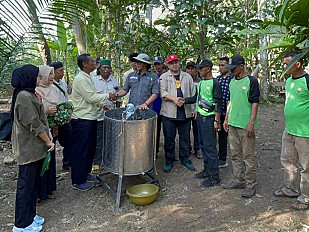
Pada Tahun Anggaran 2025, Desa Pemaatang Kulim menjadi salah satu desa yang mendapatkan dukungan dalam kegiatan pengembangan bisnis melalui program setup lebah madu. Program ini dilaksanakan bersama Kelompok Tani Hutan (KTH) Pematang Kulim dengan tujuan utama meningkatkan kemampuan kelompok dalam beternak lebah, menghasilkan madu berkualitas, serta membuka peluang usaha baru yang dapat menambah pendapatan masyarakat desa.
Melalui kegiatan ini, anggota KTH Pematang Kulim memperoleh pengetahuan dan keterampilan praktis mengenai budidaya lebah madu, mulai dari cara pemberian pakan, perawatan koloni, hingga teknik pemanenan yang tepat. Pelatihan ini tidak hanya memperkuat kapasitas individu anggota, tetapi juga menumbuhkan kesadaran akan pentingnya pemanfaatan potensi alam desa secara berkelanjutan.
Dalam pelaksanaannya, KTH Pematang Kulim telah aktif mengikuti berbagai pelatihan menganai cara merawat lebah dan memanen madu. Saat ini, kondisi koloni lebah tergolong cukup baik, meskipun terdapat beberapa koloni yang kabur sehingga sedikit mengurangi jumlah produksi. Kendati demikian, kelompok tetap berupaya menjaga kestabilan koloni agar hasil panen dapat meningkat dari waktu ke waktu.
Hasil panen madu saat ini sudah bisa dilakukan setiap 15 hari sekali, namun produksinya masih tergolong sedikit dan belum dijual secara rutin. Untuk mendukung aspek pemasaran, kelompok telah menjalin kerja sama dengan beberapa Usaha Mikro Kecil (UMK) di sekitar wilayah desa, yang telah disetujui dan siap membantu distribusi produk madu ketika produksi sudah stabil.
Dari sisi kelembagaan, anggota KTH Pematang Kulim menunjukkan komitmen dan kerja sama yang baik. Tugas dan tanggung jawab telah dibagi secara jelas-mulai dari perawatan lebah, pemberian pakan, proses panen, hingga pemasaran hasil madu. Pembagian tugas yang teratu ini menjadi salah satu faktor penting dalam menjaga keberlanjutan usaha,
Secara keseluruhan, kegiatan pengembangan bisnis setup lebah madu di Desa Pematang Kulim telah memberikan dampak positif bagi kelompok dan masyarakat. Pengetahuan dan keterampilan dalam beternak lebah semakin meningkat, kerja sama pemasaran telah terbangun, dan produksi madu mulai berjalan meskipun masih terbatas. Dengan adanya dukungan berkelanjutan dan semangat gotong royong anggota kelompok, usaha lebah madu ini berpotensi tumbuh menjadi sumber pendapatan yang berkelanjutan dan menjadi contoh sukses bagi desa-desa lain dalam mengembangkan potensi lokal secara mandiri dan ramah lingkungan.
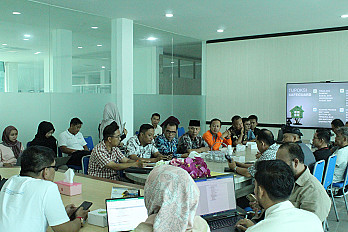
Jambi – Jambi Province is one of the regions to receive a BioCarbon Fund Initiative for Sustainable Forest Landscapes (BioCF ISFL) grant from the World Bank, following East Kalimantan as the first province to receive similar funds. This program is a global effort to support landscape-based emission reduction, forest conservation, and the socio-economic empowerment of communities surrounding forest areas.
According to Ir. H. Sepdinal, M.E., Head of the SNPMU BioCF ISFL Jambi Province, all entities with legal standing and operating in forest areas have the opportunity to receive performance-based funding (Result-Based Payment or RBP). However, the position of Remote Indigenous Communities (KAT) in this scheme still requires special attention, especially since most lack formal legal standing or a Decree (SK) from the local government.
"KAT can be included in the performance group, but because they lack legal standing, funds cannot be disbursed directly to the community. They need to collaborate with area managers such as Forest Management Units (KPH) or National Parks (TN)," explained Sepdinal.
In such circumstances, the Forest Management Unit (FMU) or National Park (TN) is obligated to help fund and foster the activities of the KAT within their jurisdiction. Meanwhile, for KAT living outside forest areas, assistance opportunities are more focused on village-based socio-economic allocations.
World Bank Standards and Principles
Yunasri Basri, from the BioCF Safeguards Division of the Jambi Province ISFL, explained that BioCF implementation must adhere to the World Bank's Environmental and Social Standards, which include socio-environmental impact assessments, biodiversity conservation, protection of indigenous communities, and preservation of cultural heritage.
Specifically for KAT, the national legal basis used is Ministerial Regulation No. 9 of 2012 and Ministerial Regulation No. 12 of 2015, which classify KAT into three categories:
Category 1: nomadic hunter-gatherer communities with minimal interaction with the outside world.
Category 2: shifting cultivators with limited interaction with the surrounding community.
Category 3: settled communities engaged in farming, fishing, or gardening.
However, various obstacles are still encountered in the field, ranging from a lack of accurate data, the absence of a clear benefit distribution scheme, to uncertainty regarding management areas.
Voices from the Regions: Conditions of Indigenous Peoples (KAT) in Regencies and Cities
Each regency in Jambi reports varying conditions for Indigenous Peoples (KAT).
Merangin Regency recorded 13 Indigenous Peoples (KAT) groups (Suku Anak Dalam/SAD) with a total of 1,267 people. Most still live in and around forest areas, with low levels of legality.
Sarolangun Regency has 507 Indigenous Peoples (KAT) families, most of whom are settled and have population data. In fact, some SAD members have worked in plantations, and some are members of the Indonesian National Armed Forces (TNI) and the Indonesian National Police (Polri).
Tebo Regency has 1,146 Indigenous Peoples (KAT) spread across nine villages. There is also the Talang Mamak Tribe, which has settled and is categorized as Category 3.
Sungai Penuh City and Kerinci Regency are still in the process of clarifying their status, as the majority of their indigenous people are farmers around Kerinci Seblat National Park (TNKS).
Batanghari, West Tanjung Jabung, and East Tanjung Jabung Regencies also have indigenous groups with varying circumstances, from those still nomadic to those who are economically independent.
In Muaro Jambi Regency, 2,473 indigenous people are reported to have settled and have permanent jobs.
In addition to the government, NGOs such as KKI WARSI, Pundi Sumatera, and Gita Buana play an active role in assisting these communities, both in economic empowerment and advocacy for indigenous peoples' rights.
The Role of the Social Services Agency: Data Guardian and Primary Facilitator
Almost all discussion participants emphasized that the Social Services Agency (Dinsos) is the primary data guardian for the KAT (Regional and Indigenous Peoples) in each district/city. Dinsos is responsible for data collection, categorization, and coordination with the Forest Management Unit (KPH), National Parks, and other supporting institutions.
Yunasri Basri emphasized,
"The SNPMU only accepts data provided by Dinsos. We have no authority to intervene or change that data."
The Jambi Provincial Social Services Agency will be responsible for coordinating all data from districts/cities, while the Regency Social Services Agency will be the field implementer who interacts directly with the community.
Challenges and Hopes
From the various discussions, several key challenges emerged:
The lack of official legality (Governor's/Regent's Decree) for most KAT groups.
Data is incomplete and has not been separated by category and location (inside or outside forest areas).
Limited livelihood opportunities for KAT, especially in areas that are already entirely forested.
However, amid these challenges, various inspiring stories have emerged. Several SAD members in Merangin have continued their education to university. In Tebo, KAT Talang Mamak has begun collaborating with companies and NGOs to protect forests and develop economic enterprises.
Moving Forward: Synergy and Data Validation
This coordination meeting emphasized that the categorization of indigenous peoples (KAT) remains guided by Ministerial Regulation No. 9 of 2012, and that the Social Services Agency is the primary data provider. Data needs to be updated and separated by category and residential location.
Furthermore, follow-up meetings will be held involving the Forest Management Units (KPH) and National Parks in each district to ensure the validation of KAT data. It is hoped that all KAT in Jambi Province will be properly recorded and receive equitable and sustainable benefits from the BioCF program.
Conclusion
The initiative to collect data and strengthen the role of KAT in the BioCF ISFL program is not only about distributing aid, but also about ensuring that indigenous communities and forest communities have an equal place in sustainable development.
Through collaboration between the government, conservation institutions, and civil society organizations, Jambi strives to make the BioCF program not just an environmental project, but also a tangible manifestation of social justice for indigenous communities who have long protected the forests.
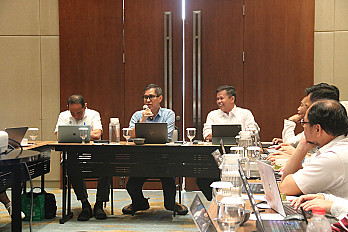
Tangerang, 12 June 2025 - The commitment of Jambi Province in climate action has now entered an important milestone with the completion of the Environmental and Social Due Diligence (ESDD) document for the Jambi Emission Reduction Program (JERP). This document serves as one of the main prerequisites for the Ministry of Environment, Ministry of Forestry, and the Provincial Government of Jambi to access result-based payments (Result-Based Payment/RBP) from the World Bank through the BioCarbon Fund (BioCF) scheme in the Jambi Emission Reduction Program (JERP). Furthermore, this document emphasizes that efforts to reduce carbon emissions in Jambi Province are carried out fairly, transparently, and responsibly concerning social and environmental aspects.
ESDD is not just about emission numbers—it speaks of forests, indigenous communities, small farmers, and the ecological future in Jambi that is sustainable. This document is not merely an administrative requirement. It becomes proof of the province's responsibility towards social and environmental risks, as well as an important stepping stone towards a fair green transition.Thus, the results of the discussion that finalize the draft ESDD document were held in Tangerang, June 11-12. The preparation was carried out by the Jambi local government, the national and subnational Safeguard Team, as well as independent consultants. This activity was also attended by the Director of Climate Change Mitigation of the Ministry of Environment and Forestry, accompanied by the Director of Resource Mobilization for Climate Change Control, and the Chair of the Subnational Project Management Unit (PMU) Jambi.
What is ESDD and What is its Function?
Environmental and Social Due Diligence (ESDD) is an assessment document aimed at evaluating the compatibility of emissions reduction program implementation with environmental and social protection standards. This document serves to: (1) assess compliance with the Environmental and Social Management Framework (ESMF) and the 10 World Bank safeguard standards (ESS1–ESS10), (2) measure the effectiveness of risk management in the field, (3) identify systemic gaps in program implementation, and (4) determine readiness to receive results-based payments (RBP). ESDD is an important tool to ensure accountability, transparency, and inclusiveness in the climate agenda.
Process of Preparing ESDD Documents
The preparation of the ESDD JERP document has gone through a series of technical and consultative stages, starting from the initial meeting on March 18–19, 2025, which was then reinforced in follow-up sessions on May 14–15, 2025. This process involves stakeholders from various sectors at the national, provincial, and local levels.
This due diligence is not for administrative compliance but is a form of accountability of the Indonesian Government towards the social and environmental impacts arising from the JERP. Therefore, this activity needs to carefully sift through activity data and select 14 sampling activities that represent the overall approach.
This document is prepared based on three main components of the JERP Program outlined in the Emission Reduction Program Document (ERPD), namely: strengthening institutional frameworks and governance policies for forest/land; sustainable forest and land management and strengthening low-emission value chains; and program coordination, safeguard reporting, and grievance redress systems (FGRM). Evaluation of these three components is conducted through a retrospective approach, which includes document reviews, electronic surveys, thematic discussions, and consultations with over 4,300 stakeholders across 11 districts/cities in Jambi Province.
Each component is evaluated based on five main aspects: environmental and social risk management processes, approval mechanisms, stakeholder engagement, budget allocation, and information transparency.
Safeguard Instruments, FPIC, and FGRM
ESDD is also equipped with a Feedback and Grievance Redress Mechanism (FGRM) that allows the community, especially vulnerable groups, women, and indigenous communities, to express complaints transparently and safely. This FGRM becomes an important instrument in ensuring that the principle of Free, Prior, and Informed Consent (FPIC) is implemented comprehensively.
The implementation of FPIC has been carried out in 230 villages spread across 10 districts/cities in Jambi Province during the 2022–2024 period, and it serves as an important foundation for the recognition of indigenous people's rights.
In terms of conservation, monitoring activities in areas of high conservation value (High Conservation Value/HCV) have been carried out through regular patrols and the installation of camera traps. Moving forward, these activities will be strengthened into a more effective and structured long-term monitoring system.
It is very important to see ESDD as an instrument for improvement, not just evaluation.
We cannot discuss climate success without addressing social justice. ESDD exists as a guarantor that no party will be sacrificed in the decarbonization agenda.
Strengthening REDD+ Synergy and Green Growth in Jambi
As part of the national REDD+ architecture, the implementation of the Joint Emission Reduction Program (JERP) demonstrates how a jurisdiction-based approach can have a real impact if supported by solid institutions and meaningful community involvement. This program also shows that strong safeguard mechanisms are not only important to meet donor requirements, but also serve as an essential tool to build trust between the government, indigenous communities, and development partners.
On the one hand, the Jambi Environmental Restoration Program (JERP) is also in line with the low-carbon development direction of Jambi Province, which has been outlined in the Green Growth Plan (GGP). The collaboration between local government, international partners, and local actors in the implementation of JERP strengthens the position of GGP as a sustainable development framework at the provincial level. With this synergy, Jambi is not only striving for emission targets but also ensuring that economic development and environmental protection can go hand in hand.
Editorial Note
The finalization of ESDD in Jambi Province marks not just an administrative milestone, but also substantial progress in the implementation of REDD+ safeguard principles in Indonesia. This document reflects how global climate policies can be concretely and operationally translated at the subnational level — by placing the rights of indigenous peoples, the involvement of vulnerable groups, and participatory governance as core foundations.
This success becomes a national learning model that demonstrates that carbon emission reduction programs are not just about numbers, but about ensuring social and environmental sustainability in a balanced way. With an operational grievance mechanism, strengthened legal recognition of customary rights, and the active role of local stakeholders, Jambi has now become one of the most tangible examples of how social justice can be at the heart of climate action. This is a form of green transition that is not only effective but also just.
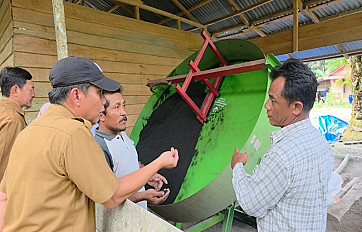
Muaro Jambi – Amidst the growing trend of sustainable agricultural development, Nyogan Village in Mestong District, Muaro Jambi Regency, has become a shining light in efforts to increase the productivity of smallholder crops. Through a program from the Jambi Province Food Crops, Horticulture, and Livestock Service (TPHP), the Karya Abadi Farmers Group received concrete support to increase its capacity in animal feed and compost processing.
Training and Equipment Assistance: The Beginning of Change
In the 2024 fiscal year, the TPHP Service held a Technical Guidance (Bimtek) for members of the Karya Abadi Farmers Group. This training provided not only knowledge but also practical skills on how to process animal feed into silage, as well as how to utilize livestock and plantation waste to create organic compost.
In addition to training, this group also received assistance with facilities and infrastructure, including a granulator, a cultivator, forage seeds such as odot and indigofera, and various other supporting equipment. With this support, the farming group began producing feed and compost for their own needs and those of the surrounding community.
From Waste to Fertilizer: Innovation Amidst Limitations
After participating in the technical guidance, group members were able to independently process livestock waste (manure, urine, leftover feed) and plantation waste (palm fronds and waste) into compost and forage for livestock. While compost production is still small-scale, it is sufficient to meet the group's needs and is sold in limited quantities to the village community.
Strikingly, the quality of the compost produced was tested at the Jambi Ministry of Agriculture's BSIP soil laboratory. The results were quite good, although the nitrogen (N) content was found to be low—an element that is crucial for the growth of oil palms, which are widely cultivated in the area.
Field Challenges: Livestock Diseases and Lack of Raw Materials
Despite showing progress, the Karya Abadi Farmers Group's journey has not been without obstacles. One serious problem is the dwindling livestock population. From an initial 12, only two remain. Diseases such as scabies and Jembrana are the main causes of livestock deaths.
Furthermore, the lack of permanent pens in surrounding villages makes collecting livestock manure for compost difficult. Without an adequate waste supply, compost production is hampered.
As a solution, the group is trying to innovate by using solid factory waste as an alternative raw material. This method has been used twice, but it faces challenges in mobilizing oil palm fronds, which requires proper transportation.
Seedlings Not Growing Optimally: Dry Season a Barrier
Other efforts to support animal feed production, such as planting odot grass and indigofera, have also not been optimal. Seedling assistance provided during the dry season resulted in very low germination rates—only around 30% for odot, while indigofera almost completely dried up.
The Way Forward: Further Support Needed
Despite facing a number of obstacles, the enthusiasm of the farmers in Nyogan Village remains high. They have demonstrated that with proper training and adequate tools, waste processing can become a productive resource that supports local agricultural and livestock activities.
However, to maintain sustainability, additional support is needed in the form of:
- Preventive livestock health care,
- Assistance with collective pens to facilitate waste collection,
- Improving seed distribution times according to the planting season,
- And logistical support for raw material mobilization.
Nyogan Village is proof that when farmers are equipped with the knowledge, tools, and mentoring, they can become agents of change for sustainable agriculture—even though the path they take remains challenging.
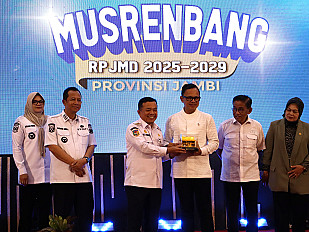
Bio Carbon Fund - ISFL Jambi - Jambi Governor Al Haris emphasized the importance of program synchronization between the central and regional governments in order to sharpen and align central and regional programs in the same direction in Development. He conveyed this assertion when attending the Development Planning Meeting (Musrenbang) for the Jambi Province Medium-Term Development Plan (RPJMD) for 2025-2029, held at the Swiss Bell Hotel, Jambi City, Wednesday (21/05/2025). Before the Musrenbang began, Governor Al Haris directly checked the attendance of the regents/mayors one by one and immediately gave a stern warning to the regents who were absent and only sent their representatives. According to Governor Al Haris, because this Musrenbang activity is very important, at least the regents/mayors who are unable to attend can send a deputy regent/deputy mayor.
"This Musrenbang is very important to synchronize the work program activities of the district to the center so that they can be in line. Because the Government is making simultaneous Pilkada to align district, provincial and national programs," said Governor Al Haris.
Governor Al Haris said, one of the stages of the preparation of the RPJMD regulated in the Regulation of the Minister of Home Affairs Number 86 of 2017 concerning Procedures for Planning, Controlling and Evaluation of Regional Development, Procedures for Evaluation of Draft Regional Regulations on RPJPD and RPJMD, and Procedures for Amendments to RPJPD, RPJMD and RKPD is the Musrenbang RPJMD.
"The Musrenbang RPJMD for 2025-2029 is an important momentum for the development of Jambi Province for the next five years, because it is a medium for sharpening, aligning, clarifying and agreeing on the goals, targets, strategies, policy directions, and regional development programs that have been formulated in the initial draft of the RPJMD," said Governor Al Haris.
On that occasion, Governor Al Haris explained the macro conditions of Jambi Province. In 2024, Jambi's economy grew by 4.51 percent, and amidst global uncertainty, Jambi's economy continued to grow quite well in the first quarter of 2025 by 4.55 percent compared to the first quarter of 2024 (year on year). In this quarter, growth occurred in all business sectors, except for the construction sector which contracted by 0.83 percent. Meanwhile, the structure of Jambi Province's GRDP did not show significant changes, still dominated by the agriculture, forestry and fisheries business sector by 34.11 percent, and the mining and excavation business sector by 13.83 percent.
"The Open Unemployment Rate in February 2025 was at 4.48 percent or the same as in August 2024. However, the number of working population increased by 26.3 thousand people compared to February 2024 or increased by 1.48 percent," explained Governor Al Haris.
"For the percentage of poor people, we have succeeded in reducing it from 7.58 percent in March 2023 to 7.26 percent in September 2024. Improvements in most of these macro indicators cannot be separated from the success of Jambi Province in controlling the inflation rate at around 1.43 percent in 2024 and inflation until April 2025 of 2.1 percent (year to date)," he continued.
Governor Al Haris, referring to the strategic issues and the Vision of JAMBI MANTAP Competitive and Sustainable in 2029 under the Ridho of Allah SWT, there are three missions that will be implemented. "There are three missions that will be implemented, (1) Strengthening Effective and Efficient Governance, (2) Strengthening Regional Competitiveness and Productivity in the Fields of Agriculture, Trade, Industry and Tourism, and (3) strengthening sustainable development and quality of human resources," said Governor Al Haris.
"The first mission aims to realize accountable, transparent and adaptive governance. While the second mission aims to increase regional competitiveness by optimizing superior sectors. While the third mission has two objectives, namely the first is to realize a low-carbon economic system, efficient in the use of resources, and socially inclusive, and the second is to realize quality, cultured and gender-equal human resources," he continued.
Furthermore, Governor Al Haris also said that in the future there are 12 priority programs that will be implemented in the next five years, namely (1) Bureaucratic Reform, (2) Digitalization of public services, (3) Increasing Regional Fiscal Capacity, (4) Development of Areas and Infrastructure in the Agricultural, Trade, Industry and Tourism Sectors, (5) Development of Start Up Ecosystems, Technological Innovation and Digital Transformation of MSME and Cooperative Products, (6) Increasing Agricultural Land Productivity to Support Village and Regional Food Barns, (7) Development of the Sengeti Tungkal Sabak Strategic Area or SENTUSA as a Fast Growing Area, (8) Facilitating the Acceleration of Energy Security to Support Strategic Areas, (9) Accelerating the Development of Regional Transportation Logistics Systems, (10) Strengthening the Primary Health System and Improving the Quality of Education, (11) The Jambi Advance Network Program abbreviated as PRO-JAMBI, and (12) Reducing GHG Emissions Towards Net Zero Emissions.
"Specifically for PRO JAMBI, this program is a Quick Wins in an effort to accelerate the reduction of development inequality and poverty reduction which will be carried out every year during our leadership. This program will be implemented by the Regional Apparatus for menus that are the authority of the Provincial Government, as well as in the form of financial assistance for menus that are not the authority of the Provincial Government. The first menu is Pro Jambi Cerdas with educational assistance activities for high school/vocational school students from underprivileged families, and S1, S2 and S3 scholarships for the public, as well as vocational education in partnership with Institutions/Business Worlds both domestically and abroad," said Governor Al Haris.
In addition, Governor Al Haris also revealed, the second menu is Pro Jambi Healthy, including BPJS health subsidies for poor families, nutritional assistance for pregnant women, toddlers and adolescents, and a healthy living community movement. The third menu is Pro Jambi Tangguh, including home renovation, working capital assistance for MSMEs/Home Industries/start-ups/millennials, assistance for agricultural, livestock, plantation, fisheries and forestry infrastructure, operational assistance for traditional institutions, increasing life skills for millennials/Gen Z ready to work, job fairs or stable competitive job exchanges, work accident insurance and death insurance for Vulnerable Workers, and 2 percent cheap credit for farmers, fishermen and traditional market traders. The fourth menu is Pro Jambi Responsif, in the form of assistance for the disabled, abandoned children, the elderly and the socially disadvantaged, incentives for Babinsa/Babinkamtibmas, forming a BERSINAR Village or Drug-Free Village and the Lapor Wak DUL channel (Wo Haris and Pak Dul) which collects aspirations and public complaint services.
"The last menu is Pro Jambi Agamis, in the form of honorariums for religious employees, religious teachers and Madrasah Diniyah Takmiliyah and Islamic Boarding Schools, honorariums for sub-district Dai, free umrah assistance for religious teachers, Quran memorizers and outstanding religious employees, and the one village one Quran memorizer program," said Governor Al Haris.
Governor Al Haris also invited all regents/mayors throughout Jambi Province to commit together to achieving the development targets of Jambi Province. The same commitment is also for all Heads of Regional Apparatus within the Jambi Provincial Government. "We all must be more intensive in coordinating with the Central Government, including coordination between us in the Jambi Provincial Government and the Regency/City Governments throughout Jambi Province and other stakeholders, so that the development we carry out can synergize, have leverage, and provide the greatest possible benefits to the community," concluded Governor Al Haris.
Meanwhile, the Deputy Minister of Home Affairs (Wamendagri) of the Republic of Indonesia, Bima Arya Sugiarto in his remarks strongly supported the Governor's reprimand to the two regional heads who did not send their deputies with a stern warning, because they were not present and were not represented by their deputy regents to attend the 2025-2029 Jambi RPJMD Musrenbang. "The discipline shown by Governor Al Haris to the regents is what was instilled in the retreat from ministers to governors. That is what the regents/mayors must understand to tidy up our bureaucracy," said Wamendagri Bima Arya.
Bima Arya also explained that President Prabowo was inspired by the Chinese reformist figure, Deng Xiaoping. The figure is known to have succeeded in driving significant changes in his country to become one of the countries with the largest economic power in the world. It is hoped that this spirit can also be possessed by leaders in Indonesia. "I invite you to understand the President's way of thinking before we tinker with the RPJMD and so on," he explained.
In this Musrenbang, Governor Al Haris and Chairman of the Jambi Provincial DPRD M. Hafiz also witnessed the signing of the Agreement on the Minutes of the Musrenbang RPJMD Jambi Province for 2025-2029 by the regents/mayors throughout Jambi Province.